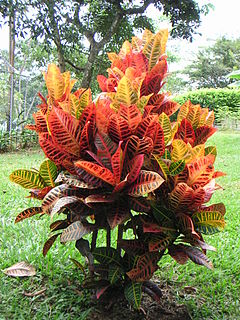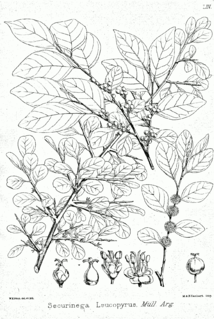
Amperea is a plant species of the family Euphorbiaceae first described as a genus in 1824. The entire genus is endemic to Australia.
Amyrea is a plant genus of the family Euphorbiaceae first described as a genus in 1941. It is native to Madagascar and to nearby Mayotte Island in the Indian Ocean.

Chrozophora is a plant genus of the family Euphorbiaceae first described as a genus in 1824. It comprises monoecious herbs or undershrubs. The genus is widespread across Europe, Africa, and Asia.
Acidoton is a genus of plant of the family Euphorbiaceae first described as a genus in 1788. It is native to the Greater Antilles, Central America, and tropical South America.
Argomuellera is a genus of plant of the family Euphorbiaceae first described as a genus in 1894. It is native to sub-Saharan Africa, Madagascar, and the Comoros Islands.
Benoistia is a genus of shrubs or trees of the spurge family (Euphorbiaceae) and the monotypic subtribe Benoistiinae. It was first described as a genus in 1939. The entire genus is endemic to Madagascar.
- Benoistia orientalisRadcl.-Sm. - N + E Madagascar
- Benoistia perrieriH.Perrier & Leandri - Madagascar
- Benoistia sambiranensisH.Perrier & Leandri - N Madagascar

Codiaeum is a genus of plants under the family Euphorbiaceae first described as a genus in 1824. It is native to insular Southeast Asia, northern Australia and Papuasia.

Petalostigma is a genus of plants under the family Picrodendraceae and the monogeneric subtribe Petalostigmatinae, first defined by von Mueller in 1857. It is native to New Guinea and Australia.
Anthostema is a flowering plant genus in the Family Euphorbiaceae first described as a genus in 1824. It is native to Africa and Madagascar.
- Anthostema aubryanumBaill. - W + C Africa from Ivory Coast to Cabinda
- Anthostema madagascarienseBaill. - Madagascar
- Anthostema senegalenseA.Juss. - W Africa from Senegal to Benin

Bertya is a genus of plants in the family Euphorbiaceae first described as a genus in 1845. The entire genus is endemic to Australia.
Adenopeltis is a plant genus of the family Euphorbiaceae first described as a genus in 1832. Its name comes from Greek and means "glandular shield". It contains only one known species, Adenopeltis serrata, endemic to the central part of the Republic of Chile in South America.

Microstachys is a genus of plants in the Euphorbiaceae first described as a genus in 1824. It is native to tropical Africa, southern Asia, Australia, Papuasia, Mesoamerica, the West Indies, and South America.
Thecacoris is a genus of flowering plant belonging to the family Phyllanthaceae first described as a genus in 1821. It is native to tropical Africa and Madagascar. It is dioecious, with male and female flowers on separate plants, although it may rarely be monoecious.
Keayodendron is a genus of plants in the family Phyllanthaceae first described as a genus in 1959. It contains only one known species, Keayodendron bridelioides, native to tropical western and Central Africa. It is dioecious, with male and female flowers on separate plants.

Securinega is a genus of plants in the family Phyllanthaceae, first described as a genus in 1789. As presently conceived, the genus is native to Madagascar and the Mascarene Islands in the Indian Ocean. In the past, it was considered to be much more widespread, thus explaining the long list of species formerly included. It is dioecious, with male and female flowers on separate plants.
- Securinega antsingyensisLeandri - W Madagascar
- Securinega capuroniiLeandri - W Madagascar
- Securinega durissimaJ.F.Gmel. - Madagascar, Mauritius, Réunion, Rodrigues Island
- Securinega perrieriLeandri - W Madagascar
- Securinega seyrigiiLeandri - W Madagascar
Lingelsheimia is a plant genus variously classified in the families Putranjivaceae or Phyllanthaceae, first described as a genus in 1909. It is native to central Africa and Madagascar.
- Lingelsheimia abbayesii(Leandri) Radcl.-Sm. - Madagascar
- Lingelsheimia ambigua(Leandri) Radcl.-Sm. - Madagascar
- Lingelsheimia fiherenensis(Leandri) Radcl.-Sm. - Madagascar
- Lingelsheimia frutescensPax - Gabon, Zaire
- Lingelsheimia manongarivensis(Leandri) G.L.Webster - Madagascar
- Lingelsheimia sylvestris(Radcl.-Sm.) Radcl.-Sm. - Tanzania

Laportea is a genus of plants in the family Urticaceae. They are herbaceous, either annual or perennial. Like many plants of the Urticaceae, they have stinging hairs. There are stinging and non-stinging hairs on the same plant. The genus was named after the French naturalist Francis de Laporte de Castelnau.

Flueggea, the bushweeds, is a genus of shrubs and trees in the family Phyllanthaceae first described as a genus in 1806. It is widespread across much of Asia, Africa, and various oceanic islands, with a few species in South America and on the Iberian Peninsula.

Stachystemon is a plant genus in the family Picrodendraceae first described as a genus in 1845.









